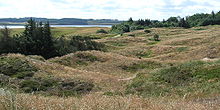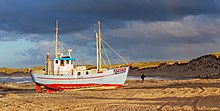Thy (district)

Thy (Danish pronunciation: [ˈtʰyˀ], local dialect [ˈtʰyi̯kʲʰ]) is a traditional district in northwestern Jutland, Denmark. It is situated north of the Limfjord, facing the North Sea and Skagerrak, and has a population of around 44,000. The capital is Thisted. Snedsted, Hanstholm and Hurup are minor towns in the area.
Since the Danish municipal reform of 1 January 2007, Thy is roughly identical with
Thy forms the western part of the
Nature

Thy has a very varied landscape. In the north it is marked by flat coastal plains which were covered by sea in Neolithic times, but fell dry because of the post-glacial rebound. These are interrupted with higher-lying plains that were islands in the Neolithic sea. In the slopes that formed the coast in these times, high-lying limestone is often visible - hence the name of the Limfjord. The eastern stretch, facing the Limfjord, has quite fertile soil, is slightly hilly and dotted with small villages and farms like the landscape in most of rural Denmark. The landscape is marked by strong western winds, most trees bending eastwards.
The west coast has wide beaches and high
The wetlands
.Thy national park
On 22 August 2008, Thy National Park officially opened, as the first of three realized national parks out of seven planned.
On 10 July 2007, a police officer from
On 19 November 2012, a dead
History
Thy is originally the same word as
Antiquity
In the Stone Age, probably before it got its later name, Thy exported fine flint present in the limestone. A Neolithic flint quarry has been restored at Hov east of Thisted. Thy was densely populated in the Bronze Age and has a great number of burial mounds.
Middle Ages
In the Viking Age the area had vital trade links across the North Sea, being Christianised from England by Saint Theodgarus, a missionary originally from Thuringia and trained in England, unlike other parts of Denmark that were Christianised from the south. The former cathedral and monastery of Theodgarus in Vestervig is today the largest village church of Scandinavia. In 1085 Thy was the gatehead for King Canute the Holy's plans to retake England from William the Conqueror, with 1,000 ships gathered in the Limfjord until the expedition was cancelled and a peasant uprising broke out.
World War II
In the
have been restored and are open to the public.Economy
Thy is still a mainly rural area, the traditional businesses of agriculture and fishery being more prevalent than in many other areas of Denmark.

Tourism
Tourism is a major business in summer, the coastal villages receiving many German tourists and smaller numbers of Norwegians, Swedes, Dutch and others. Although the coastal resorts have areas with individual holiday houses, they maintain a native population as well. The only major hotel-like holiday complex is at Vigsø Bugt east of Hanstholm. Thy has become a major destination for windsurfing.
Industry
There is some small and medium scale
Education
Secondary education includes the
The Nordic Folk Centre for Renewable Energy is internationally known for its research in
Infrastructure
With its position in the northwestern corner of Jutland, Thy is far from the greater
Roads
- National route 26, in part a motorway and European route E45).
- National route 11 passes through Thy from north to south on its way from Aalborg down to the German border at Tønder.
- National route 29 goes from Hanstholm eastwards to the E45 motorway at Hobro.
- Secondary national route 181 is part of the heathlandscape along the coast.
Bridges
- Oddesund Bridge (southwards to western Jutland, carries national route 11 and railway)
- Vilsund Bridge (eastwards to the island of Mors and from there onwards to central Jutland, national route 26)
Railways
- The Thy Line (Thisted-Struer), local trains operated by Arriva as well as two daily Intercity trains to Copenhagen.
- A railway from Thisted to Aalborg via Fjerritslev existed from 1904 to 1/4-1969.
Ferries
To the Faroe Islands, Iceland and Norway:
- Hanstholm - Tórshavn-Seyðisfjörður Smyril Line
- Hanstholm - Kristiansand Thy ferries cargo as (in Norwegian)
Small internal ferries on the Limfjord:
- Agger-Thyborøn (connecting the two sand spits at the western mouth of the Limfjord, on route 181)
- Neessund (to Mors)
- Feggesund (strictly speaking from Hanherred to Mors)
Airports
- Thisted Airport, currently no scheduled traffic
The closest airports with scheduled flights are
See also
References
- ^ Vejlerne
- ^ Hermit re-united with parents, Thisted Dagblad/Nordjyske, 11 July 2007 (in Danish)
- ^ Yep, it was a wolf The Copenhagen Post (07.12.12)
- ^ "Wild boars make a comeback too". The Copenhagen Post. 1 March 2013.
- ^ Breeding wolves in Jutland probable within 10 years DCE - Danish Centre For Environment And Energy (Aarhus University)
- ISBN 87-567-4462-5
- ^ baja-thisted.dk (in Danish)
External links
- Official tourist information
- Thyweb, local events, news and information (Danish and German)
